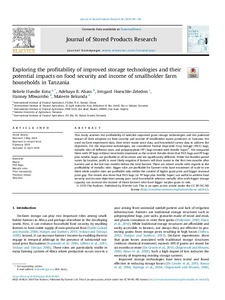| dc.contributor.author | Kotu, B.H |
| dc.contributor.author | Abass, A.B. |
| dc.contributor.author | Hoeschle-Zeledon, Irmgard |
| dc.contributor.author | Mbwambo, H. |
| dc.contributor.author | Bekunda, Mateete A. |
| dc.date.accessioned | 2019-12-04T11:33:57Z |
| dc.date.available | 2019-12-04T11:33:57Z |
| dc.date.issued | 2019-05-20 |
| dc.identifier.citation | Kotu, B.H., Abass, A.B., Hoeschle-Zeledon,I., Mbwambo, H. and Bekunda, M. 2019. Exploring the profitability of improved storage technologies and their potential impacts on food security and income of smallholder farm households in Tanzania. Journal of Stored Products Research 82, 98-109. |
| dc.identifier.uri | https://hdl.handle.net/20.500.12478/5855 |
| dc.description.abstract | This study assesses the profitability of selected improved grain storage technologies and the potential impact of their adoption on food security and income of smallholder maize producers in Tanzania. We used on-farm experiment data, time series maize price data, and household survey data to address the objectives. For the improved technologies, we considered Purdue Improved Crop Storage (PICS) bags, metallic silos of different sizes, and polypropylene (PP) bags treated with Actellic Super®. We compared them with PP bags without insecticide treatment as the control. Results show that PICS bags and PP bags plus Actellic Super are profitable in all locations and not significantly different. While the feasible period varies by location, profit is most likely negative if farmers sell their maize in the first two months after harvest and in the last two months before the next harvest. There are mixed results with regards to the profitability of metallic silos; bigger silos are profitable for farmers who have economies of scale to use them while smaller ones are profitable only within the context of higher grain price and bigger seasonal price gap. The results also show that PICS bags (or PP bags plus Actellic Super) are useful to address food security and income objectives among poor rural households whereas metallic silos with bigger storage capacity can increase the income of those farmers who have bigger surplus grain to sale. |
| dc.description.sponsorship | United States Agency for International Development |
| dc.description.sponsorship | Swiss Agency for Development and Cooperation |
| dc.format.extent | 98-109 |
| dc.language.iso | en |
| dc.rights | CC-BY-NC-ND-4.0 |
| dc.subject | Maize |
| dc.subject | Postharvest Technology |
| dc.title | Exploring the profitability of improved storage technologies and their potential impacts on food security and income of smallholder farm households in Tanzania |
| dc.type | Journal Article |
| dc.description.version | Peer Review |
| cg.contributor.crp | Maize |
| cg.contributor.affiliation | International Institute of Tropical Agriculture |
| cg.contributor.affiliation | Sokoine University of Agriculture |
| cg.coverage.region | Africa |
| cg.coverage.region | East Africa |
| cg.coverage.region | Southern Africa |
| cg.coverage.country | Tanzania |
| cg.creator.identifier | Bekele Hundie Kotu: 0000-0001-5788-6461 |
| cg.creator.identifier | Adebayo Abass: 0000-0003-1376-3608 |
| cg.creator.identifier | Irmgard Hoeschle-Zeledon: 0000-0002-2530-6554 |
| cg.creator.identifier | Mateete Bekunda: 0000-0001-7297-9383 |
| cg.researchtheme | NUTRITION & HUMAN HEALTH |
| cg.researchtheme | SOCIAL SCIENCE & AGRICUSINESS |
| cg.edition | Volume 82 |
| cg.isijournal | ISI Journal |
| cg.authorship.types | CGIAR and developing country institute |
| cg.iitasubject | Handling, Transport, Storage And Protection Of Agricultural Products |
| cg.iitasubject | Post-Harvesting Technology |
| cg.iitasubject | Smallholder Farmers |
| cg.iitasubject | Socioeconomy |
| cg.journal | Journal of Stored Products Research |
| cg.howpublished | Formally Published |
| cg.accessibilitystatus | Open Access |
| local.dspaceid | 105576 |
| cg.targetaudience | Scientists |
| cg.targetaudience | Academics |
| cg.targetaudience | Cgiar |
| cg.targetaudience | Development Practitioners |
| cg.targetaudience | Donors |
| cg.identifier.doi | https://doi.org/10.1016/j.jspr.2019.04.003 |

